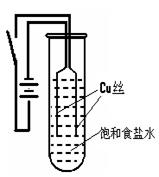(9分)某化学研究小组以铜为电极电解饱和食盐水,探究过程如下:
【实验1】:如右下图装置,电源接通后,与电池负极相连的铜丝上有大量气泡产生;与电池正极相连的铜丝由粗变细。电解开始30s内,阳极附近出现白色浑浊,然后开始出现橙黄色浑浊,此时测定溶液的pH约为10。随着沉淀量的逐渐增加,橙黄色沉淀慢慢聚集在试管底部,溶液始终未出现蓝色。

【实验2】:将实验1中试管底部的橙黄色沉淀取出,分装在两
支小试管中,以后的操作和现象如下:
| 序号 | 操作 | 现象 |
| ① | 滴入稀硝酸溶液 | 沉淀溶解,有无色气泡产生,最终得到蓝色溶液。 |
| ② | 滴入稀硫酸溶液 | 橙黄色沉淀转变为紫红色不溶物,溶液呈现蓝色 |
| 物质 | 颜色 | 物质 | 颜色 |
| 氯化铜 | 固体呈棕色,浓溶液呈绿色,稀溶液呈蓝色 | 氢氧化亚铜 (不稳定) | 橙黄色 |
| 碱式氯化铜 | 绿色 | 氢氧化铜 | 蓝色 |
| 氧化亚铜 | 砖红色或橙黄色 | 氯化亚铜 | 白色 |
(1)铜的常见正化合价为________、_______,最终试管底部橙黄色沉淀的化学式_______________。
(2) 电解开始30s内,阴极上发生的反应为: 、阳极上发生的反应为: 。
(3)写出实验2中①、②的离子方程式:①_______________;②___________________。
(1) +1、+2 (两个写全1分),Cu2O;(1分)
(2)阴极上发生的反应:2H++2e-==H2↑,(1分)
阳极上发生的反应:Cu+Cl-—e-=CuCl↓;(2分)
(3)该反应的离子方程式:3Cu2O+14H++2NO3-= 6Cu2+ +2NO↑ + 7H2O,(2分)
Cu2O+2H+ ="Cu" + Cu2++H2O。(2分)
